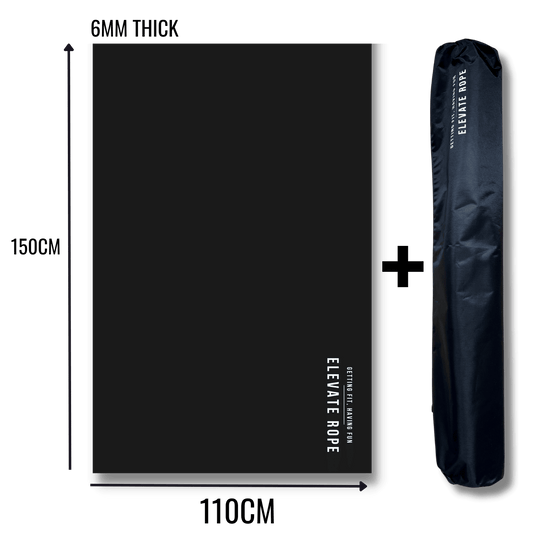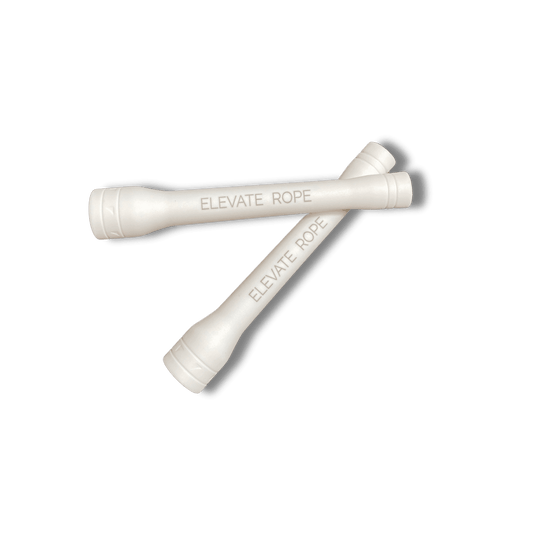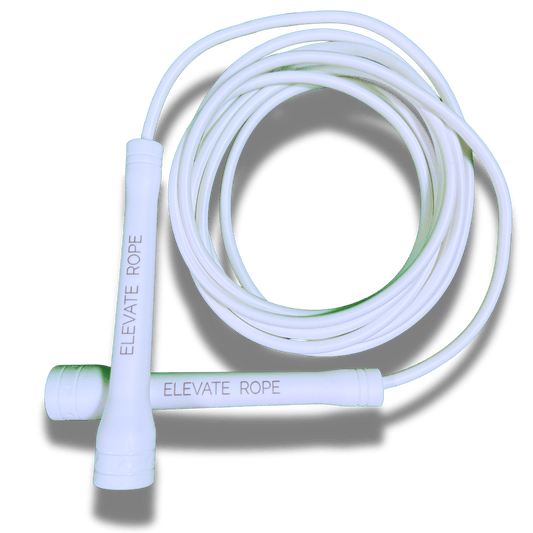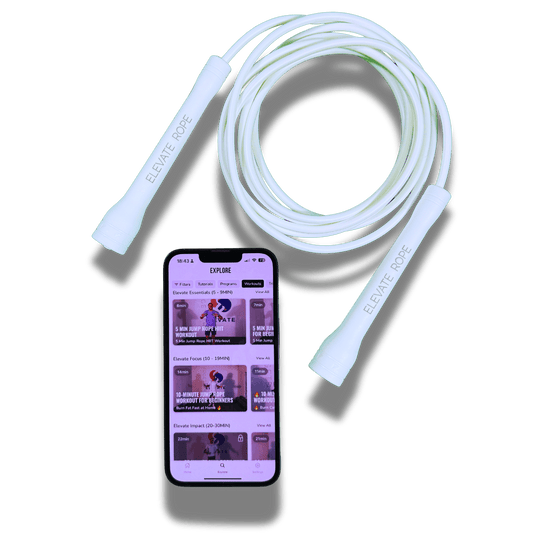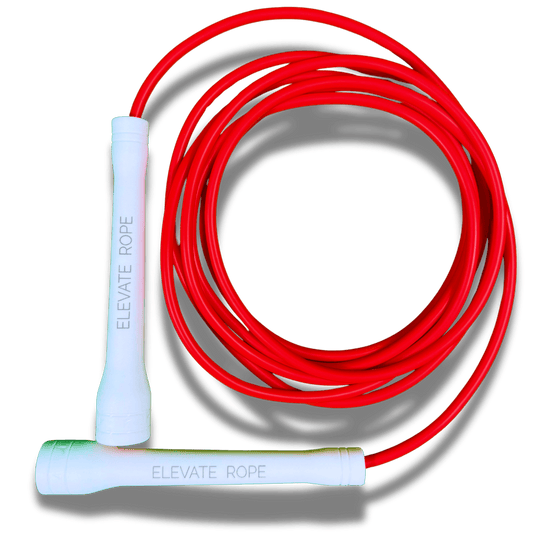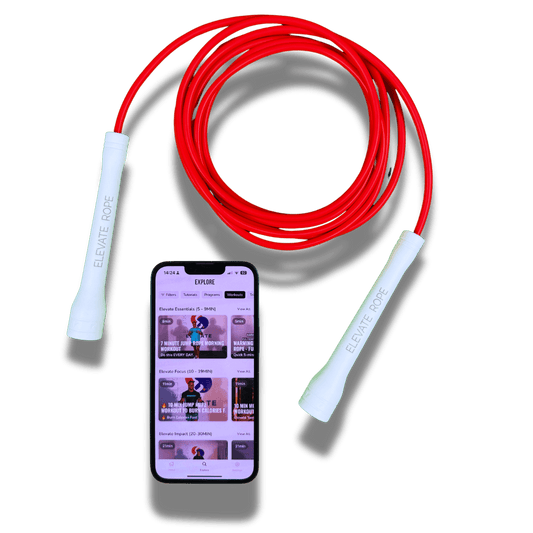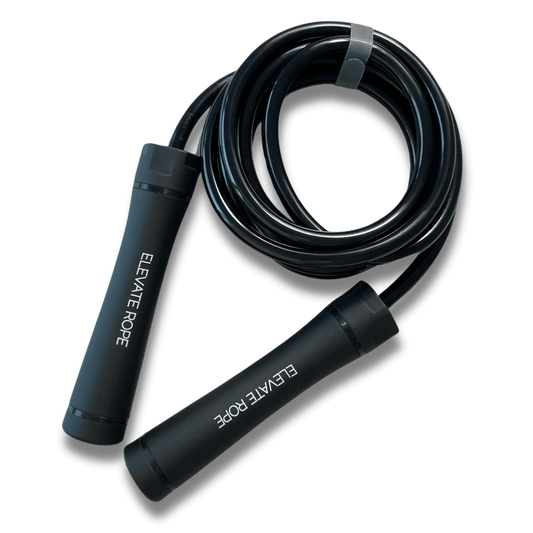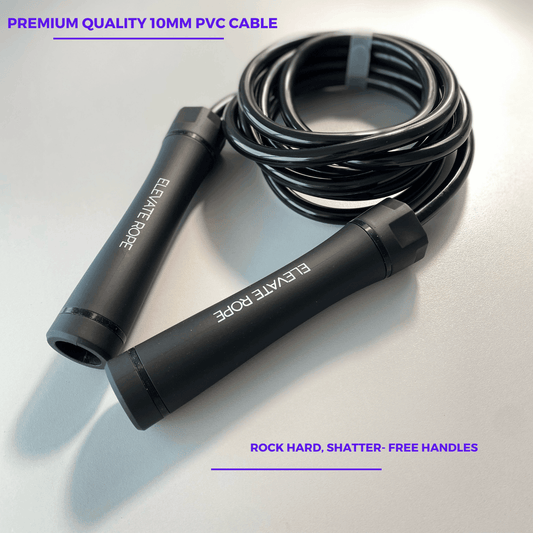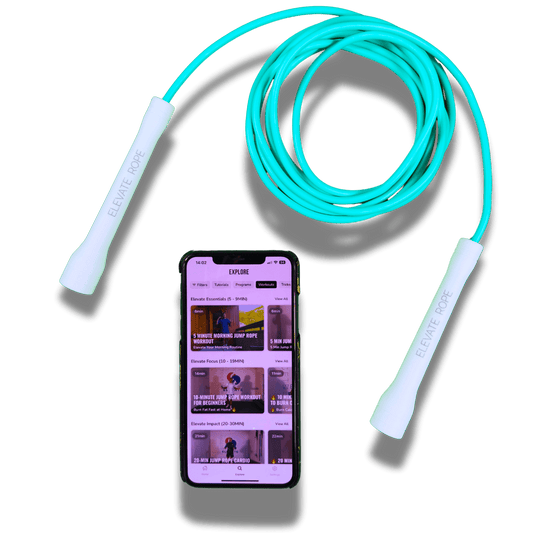5 esercizi con la corda per agilità e velocità nel calcio
Il calcio non riguarda solo l'abilità — riguarda reazione, ritmo e velocità. La differenza tra arrivare per primi sul pallone o essere un secondo troppo tardi spesso dipende dal gioco di gambe e dall'agilità.
Ecco perché sempre più giocatori e allenatori stanno aggiungendo l'allenamento con la corda ai loro programmi. È uno degli strumenti più semplici e potenti per sviluppare piedi veloci, accelerazione esplosiva e la coordinazione su cui i giocatori d'élite fanno affidamento in ogni partita.
Che tu giochi per hobby, ti alleni a livello competitivo o alleni una squadra giovanile, questi 5 esercizi con la corda per il calcio ti aiuteranno a sviluppare il tipo di controllo del movimento che fa vincere le partite.

Perché la corda funziona per i calciatori
Il calcio richiede un ritmo costante — sprint, fermarsi, pivotare, saltare, cambiare direzione, ripetere. La corda allena il tuo corpo per questi esatti schemi.
Ecco perché l'allenamento con la corda è perfetto per gli atleti di calcio:
- Primi passi esplosivi: Ogni salto sviluppa la forza elastica nei polpacci e nel tendine d'Achille — fondamentali per l'accelerazione.
- Reazioni più rapide: Lavorare con la corda migliora la velocità di risposta del sistema nervoso e il controllo del ritmo.
- Migliore equilibrio e coordinazione: Atterrare dolcemente sull'avampiede insegna la consapevolezza corporea, fondamentale per cambi di direzione rapidi.
- Resistenza e condizionamento: Intervalli brevi con la corda imitano il ritmo lavoro-riposo del calcio — scatti intensi seguiti da brevi recuperi.
- Prevenzione degli infortuni: Rinforza caviglie, ginocchia e stabilizzatori, riducendo il rischio di distorsioni o infortuni da sovraccarico.
“L'allenamento con la corda dà ai giocatori il ritmo e l'esplosività che gli esercizi con la scala non possono eguagliare.”
— Elevate Rope Coach

Benefici dell'allenamento con la corda per la performance nel calcio
Se vuoi davvero diventare più veloce, leggero e agile, ecco cosa fa per il tuo gioco un allenamento costante con la corda:
1. Piedi più veloci
Saltare la corda richiede precisione e ritmo. Col tempo, i tuoi piedi imparano a muoversi più velocemente e a rispondere più rapidamente agli stimoli visivi — perfetto per duelli uno contro uno o per pressare alto sul campo.
2. Cambi di direzione migliorati
Ogni salto mette alla prova la stabilità di anche e caviglie, rendendo più facile pivotare, scivolare e cambiare direzione senza perdere il controllo.
3. Parte inferiore del corpo più forte
Lavorare con la corda coinvolge i polpacci, i quadricipiti e i muscoli posteriori della coscia migliorando la forza dei tendini. Accelererai più rapidamente, salterai più in alto e manterrai la stabilità sotto pressione.
4. Coordinazione migliorata tra piedi e occhi
Il calcio riguarda il tempismo — non solo quanto velocemente ti muovi, ma quando ti muovi. L'allenamento con la corda sincronizza la parte superiore e inferiore del corpo, affinando il tuo tempo di reazione e la consapevolezza spaziale.
5. Più potenza con meno sforzo
Saltare la corda allena l'elasticità — la capacità di immagazzinare e rilasciare energia. Questo significa sprint più veloci e arresti più netti con meno fatica.
I 5 migliori esercizi con la corda per agilità e velocità nel calcio
Ecco cinque esercizi specifici con la corda che trasformeranno la tua rapidità, coordinazione ed esplosività sul campo.
1. Reazione con Split-Step (Partenza di Accelerazione)
Obiettivo: Sviluppare una velocità di primo passo più rapida e prontezza del corpo.
Come farlo:
- Tieni la corda davanti ai fianchi.
- Esegui due oscillazioni laterali.
- Salta in posizione divaricata — un piede avanti, uno indietro — atterrando dolcemente.
- Ripristina e ripeti con la gamba opposta.
Durata: 4 serie × 30 secondi (15s di riposo).
Perché funziona:
Questo movimento rispecchia la tua posizione di accelerazione nel calcio. Ti insegna a caricare rapidamente le gambe ed esplodere verso la palla.
Consiglio Pro: Tieni il petto leggermente in avanti e le ginocchia piegate. Senti il ritmo — reagisci non appena la corda supera i piedi.
2. Salti Laterali sulla Linea (Agilità Difensiva)
Obiettivo: Migliorare il movimento laterale e il controllo difensivo.
Come farlo:
- Immagina una linea sul terreno.
- Salta lateralmente oltre la corda con entrambi i piedi uniti, usando la corda per il ritmo.
- Rimani leggero, veloce e controllato.
Durata: 4 serie × 30 secondi (15s di riposo).
Perché funziona:
Questo esercizio imita gli scivolamenti difensivi e i recuperi laterali. Rinforza caviglie, anche e glutei — offrendoti maggiore stabilità quando marcando o tagliando il campo.
Variazione: Prova i salti su una gamba per sfidare l'equilibrio e rafforzare gli stabilizzatori.
3. Double-Unders (Potenza Esplosiva)
Obiettivo: Sviluppare esplosività verticale e reattività di tutto il corpo.
Come farlo:
- Salta una volta mentre fai ruotare la corda due volte sotto i piedi.
- Atterra dolcemente e riparti immediatamente.
Durata: 5 serie × 10 ripetizioni (30s di riposo).
Perché funziona:
Il double-under ti insegna a generare forza esplosiva in una finestra breve — ideale per gare di salto, partenze rapide e cambi di direzione potenti.
Consiglio professionale: Non oscillare con le braccia — usa cerchi veloci e piccoli con i polsi per il controllo.
4. Salti laterali da pattinatore con la corda (Equilibrio dinamico)
Obiettivo: Rafforzare la spinta laterale e il controllo dell'atterraggio.
Come farlo:
- Esegui salti laterali da pattinatore mentre giri la corda una volta per salto.
- Concentrati sull'atterraggio stabile prima di rimbalzare.
Durata: 3 serie × 20 secondi (20s di riposo).
Perché funziona:
Questo esercizio sviluppa lo stesso coinvolgimento muscolare necessario per schivare placcaggi o cambiare corsia durante uno sprint. Migliora l'attivazione dei glutei e il controllo della decelerazione — fondamentale per prevenire infortuni.
5. Shuffle di piedi veloci (Reazione di agilità)
Obiettivo: Allenare coordinazione e controllo reattivo per un gioco di gambe veloce sotto pressione.
Come farlo:
- Tieni le maniglie della corda ai lati.
- Tocca rapidamente i piedi sinistra-destra-sinistra-destra mentre la corda gira.
- Tieni le ginocchia morbide e il busto centrato.
Durata: 4 serie × 45 secondi (20s di riposo).
Perché funziona:
Simula il gioco di gambe ad alta velocità necessario durante le sequenze di dribbling o pressing. Questo è un esercizio di riscaldamento perfetto prima delle partite per preparare reazione e ritmo.
Allenamento con la corda specifico per il calcio di 15 minuti
Ecco come combinare questi esercizi in una sessione completa di agilità e velocità.
Riscaldamento (3 minuti)
- Passo di rimbalzo facile – 45s
- Oscillazioni laterali – 30s
- Passo alternato – 60s
- Salti laterali – 45s
Serie principale (10 minuti)
- Reazione con passo diviso – 30s
- Salti laterali in linea – 30s
- Shuffle piedi veloci – 45s
- Salti laterali – 30s
- Doppio salto con la corda – 30s
- Riposo – 30s
Ripeti la serie due volte.
Defaticamento (2 minuti)
- Rimbalzi leggeri – 60s
- Rotazioni della caviglia + stretching del polpaccio – 60s
💡 Consiglio: Inizia con una corda a perline per il controllo, poi passa a una corda da velocità per un turnover più rapido e un'intensità simile al gioco.
👉 Acquista Ascent MAX — Risparmia 20€
Errori comuni (e come correggerli)
Anche i giocatori atletici commettono errori tecnici che riducono l'efficacia della corda. Ecco come correggerli.
❌ Saltare troppo in alto
Sprechi energia e perdi il ritmo.
✅ Correzione: Rimani basso — 2–3 cm da terra. Concentrati su rimbalzi rapidi, non sull'altezza.
❌ Atterraggi pesanti
I salti a piedi piatti affaticano ginocchia e tibie.
✅ Correzione: Atterra dolcemente sull'avampiede con le ginocchia piegate. Atterraggi silenziosi = movimento controllato.
❌ Andare troppo veloce, troppo presto
La velocità senza controllo rovina il ritmo.
✅ Correzione: Padroneggia prima i giri lenti e puliti. Una volta costante, aumenta la velocità del 10 % a settimana.
❌ Dimensione della corda insufficiente
Una corda troppo lunga trascina e rallenta la cadenza.
✅ Correzione: Metti il piede al centro della corda — le maniglie dovrebbero arrivare alle ascelle.
❌ Saltare il riscaldamento o il recupero
Polpacci freddi = rischio di infortunio.
✅ Correzione: Riscaldamento minimo di 2–3 minuti e defaticamento di 1 minuto. Allunga polpacci e anche dopo la sessione.

📆 Piano di progressione di 4 settimane
Settimana 1 – Fondamenta
Concentrati su ritmo e coordinazione.
- Reazione con passo diviso ×3
- Salti laterali ×3
- Piedi veloci ×3
Settimana 2 – Controllo e Equilibrio
Aggiungi salti laterali da pattinatore e salti su una gamba.
Aumenta il tempo totale del 20%.
Settimana 3 – Velocità e Potenza
Introduci i double-under, riduci il riposo tra le serie.
Aggiungi uno sprint di 10 secondi dopo ogni round.
Settimana 4 – Simulazione di gioco
Combina tutti gli esercizi in sessioni HIIT da 15 minuti.
Monitora i miglioramenti nel tempo di reazione e nella distanza dello sprint.
🎯 Obiettivo: Entro la settimana 4, la tua accelerazione, decelerazione e ritmo saranno più veloci e controllati sul campo.
Integrare il lavoro con la corda nell'allenamento di calcio
Preparazione pre-allenamento (3–5 min)
Usa piedi veloci e salti laterali per riscaldare le articolazioni e affinare la reazione.
Condizionamento nei giorni di riposo (10–15 min)
Concentrati su resistenza e ritmo. Sostituto perfetto per le corse leggere.
Mantenimento in stagione (2×/settimana)
Usa sessioni brevi e controllate per mantenere l'agilità senza sovraccaricare le gambe.
Durante la bassa stagione (3–4×/settimana)
Costruisci resistenza e potenza di base. Combina con esercizi di sprint per un effetto massimo.
Scegliere la corda giusta per il calcio
| Tipo di corda | Ideale per | Vantaggio |
| Corda veloce | Esercizi ad alta intensità | Migliora la cadenza e l'efficienza cardio |
| Corda con perline | Apprendimento delle abilità e lavoro sul ritmo | Feedback chiaro e controllo del tempo |
| Corda pesante | Forza e condizionamento | Sviluppa resistenza e robustezza degli arti inferiori |

👉 Non sei sicuro quale si adatti ai tuoi obiettivi?
Prova il Pacchetto Ascent MAX — include tutti e tre i tipi più manici di qualità professionale.
Acquista Ascent MAX — Risparmia €20
Perché i calciatori amano l'allenamento con la corda
I giocatori che si dedicano all'allenamento con la corda vedono risultati reali in poche settimane:
- Reazioni più rapide e cambi di direzione più netti.
- Atterraggi più controllati dopo i salti.
- Riduzione di infortuni a caviglie e polpacci.
- Maggiore fiducia nelle situazioni uno contro uno.
È compatta, portatile e divertente — perfetta per viaggi o riscaldamenti pre-partita.
Il ritmo che costruisci con la corda migliora direttamente il tuo ritmo in campo.
“Il mio gioco di gambe è diventato più fluido e mi sentivo più leggero in ogni partita. Dieci minuti con la corda hanno cambiato il mio movimento.”
— Amir, centrocampista semi-professionista
Conclusione finale: Allenati come un professionista, muoviti come un'ombra
L'agilità non riguarda esercizi complicati — riguarda controllo, ritmo e reazione. Saltare la corda offre ai calciatori un modo a basso impatto e ad alto rendimento per sviluppare tutti e tre.
Dedica solo 10–15 minuti al giorno agli esercizi con la corda e ti muoverai più velocemente, taglierai più netto e recupererai più in fretta — esattamente quello che fanno i migliori giocatori ogni giorno.
Quindi prendi la tua corda, imposta un timer e migliora il tuo allenamento.
Perché nel calcio, la velocità è abilità — e il ritmo è potenza.
